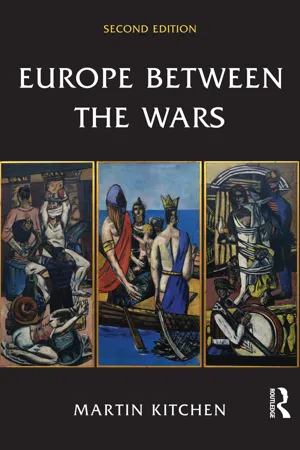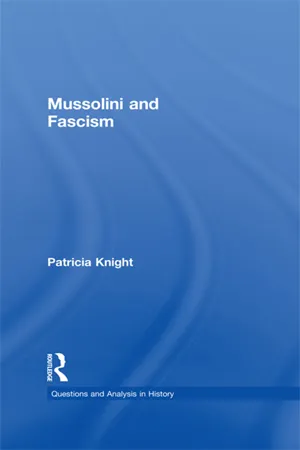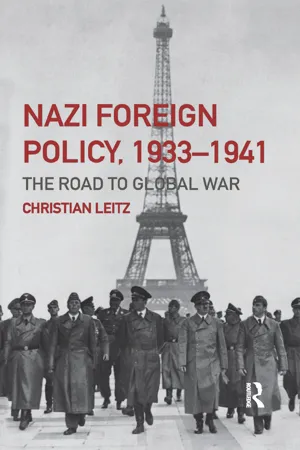History
Stresa Front
The Stresa Front was an agreement formed in 1935 between Britain, France, and Italy to oppose Adolf Hitler's decision to rearm Germany in violation of the Treaty of Versailles. The agreement aimed to maintain peace and stability in Europe, but it ultimately failed to prevent the outbreak of World War II.
Written by Perlego with AI-assistance
Related key terms
5 Key excerpts on "Stresa Front"
- eBook - ePub
- Martin Kitchen(Author)
- 2014(Publication Date)
- Routledge(Publisher)
Mussolini’s change of sides in 1936 came as something of a surprise. The Germans were still sending arms to Abyssinia and wanted to prolong the war, so as to divert Britain and France’s attention away from Europe. Once the war was over the Stresa Front could almost certainly have been revived, and Abyssinia need not have caused a fundamental realignment of Italian foreign policy. With Laval doing his trickiest best to preserve the alliance, it would seem that Mussolini acted largely out of pique at Britain and France’s efforts to negotiate a settlement, and their support, however half-hearted, of sanctions. Since Britain refused to make any continental commitment, the Stresa Front was a toothless affair that gave Italy no help at all in keeping Germany out of Austria. Germany, by contrast, appeared as a dynamic and forceful power, which was prepared to stand up against what appeared to Mussolini to be two feeble and declining states.The French would not respond to Hitler’s move without a British guarantee of support, and Eden would not take any action without full consultation. Negotiations between Britain, France and Belgium were inconclusive. Staff talks on the appropriate response to a German attack on France and Belgium resulted in Britain promising to send two divisions to France in the event of war. Although this hardly affected the military balance it was Britain’s first commitment to the defence of continental Europe since the war. The League Council met in London and condemned Germany’s violation of the treaty. Hitler’s cynical response was to suggest a new Western non-aggression pact, a demilitarised zone on both sides of the Rhine, and Germany’s return to the League.Hitler’s move was generally approved by the right in Britain and France, for they disliked the Franco-Soviet pact, and felt that Hitler had every right to do as he liked in his own back garden. Hitler was quick to exploit this situation by unleashing a massive anti-Communist campaign in the summer, and by signing the Anti-Comintern Pact with Japan in November. Most important of all, on 25 July he agreed to Franco’s request to intervene on behalf of the rebels in Spain. His motives were almost entirely political and strategic; for he was determined that Spain should not become part of the Franco-Soviet anti-German bloc, and thus seriously weaken Germany’s position in the event of a war in the east. That such thoughts were uppermost in Hitler’s mind can be seen in his memorandum on the Four Year Plan of 1936, which marked the beginning of the intensified rearmament programme, in which he reaffirmed his absolute conviction that war between Germany and the Soviet Union was inevitable. German intervention in Spain must be seen in the context of this anti-Soviet policy, and the vigorous economic activity of the Germans in Spain was a result and not the cause of this decision, as was the testing of military equipment, the positive results of which should not be exaggerated. - eBook - ePub
- Patricia Knight(Author)
- 2013(Publication Date)
- Routledge(Publisher)
However, an excuse was needed for this act of aggression and, more importantly, an assurance that Britain and France would not intervene. A pretext was easily found when thirty Italians were killed in a clash with the Abyssinians at Wal Wal on the Somali–Abyssinia frontier in December 1934. Ensuring the compliance of the western powers was more difficult though Hitler’s accession to power meant that Britain and France were now more dependent on Italian support to counteract any German moves. When in March 1935 Hitler announced rearmament the three powers convened a conference at the Italian lakeside town of Stresa. Here they formed the so-called Stresa Front, an anti-German agreement by which they undertook to act against any violation of peace treaties. Even before this, Mussolini believed he had secured French acquiescence in his plans since in January 1935 the French Foreign Minister, Pierre Laval, had agreed that France had no interests other than economic in Abyssinia, and had also given a verbal understanding that Italy might acquire political control of the country. While the French had not exactly agreed to a military take-over of Abyssinia, Mussolini felt fairly confident that they would not object.Britain was harder to convince. At Stresa the subject of Abyssinia was raised informally but there was no agreement, though Mussolini took silence to mean consent. Then in June 1935 the British Foreign Secretary, Anthony Eden, visited Rome with a plan to allocate the Ogaden region of Abyssinia to Italy and compensate Abyssinia with access to the sea via British Somaliland. Mussolini rejected this offer, but it seemed to indicate that Britain was prepared to be accommodating. Further evidence of a conciliatory attitude was a British Foreign Office report in August 1935, a copy of which was acquired by Mussolini, which suggested that Britain had no interests in Abyssinia strong enough to justify resisting an Italian conquest.11Mussolini thereupon launched his invasion in October 1935, looking forward to a quick victory, enhanced prestige and glory for the Italian army. His assessment of the British government’s attitude was largely correct but he had reckoned without the popularity of the League of Nations and the impact on public opinion, given that a British general election was pending in November. When Haile Selassie appealed to the League it imposed economic sanctions on Italy. This posed an insoluble dilemma for Britain, whose government wished to retain Italy’s support in the already weakened Stresa Front but at the same time felt obliged to uphold the authority of the League as the guarantor of collective security. - eBook - ePub
Nazi Foreign Policy, 1933-1941
The Road to Global War
- Christian Leitz(Author)
- 2004(Publication Date)
- Routledge(Publisher)
During the first months of 1935, the Nazi regime was riding on a wave of foreign policy victories. Over 90 per cent of the Saar electorate, more than anticipated by both the German and French governments, had voted in favour of a return to the Reich. Only two months later, Hitler ordered the implementation of a long-held goal of the army leadership, the introduction of conscription. Yet, Hitler’s quest to rearm Germany continued unobstructed. During Anglo-French talks in London at the beginning of February, Germany’s rearmament had, in fact, received the blessing of the two West European powers even though they still entertained the illusion that Nazi Germany could be convinced to join a multilateral security system. Against all the odds, the French government even hoped to convince Germany to join a Locarno-style pact guaranteeing the borders of Germany’s East European neighbours.Hitler’s answer to the conciliatory approaches from both France and Britain came ‘by return’. Announcing it as a reaction to the extension of military service in France, Hitler removed one of the major limitations of the Versailles Treaty and, on 16 March 1935, increased the size of Germany’s armed forces to 300,000 troops, the latter in itself a temporary step soon to be increased. This time, however, France, Britain and Italy were seemingly intent on reacting more resolutely to the worrying growth in Germany’s strength. At Stresa in April, an attempt was made to establish a common front against Germany’s growing revisionism.Ultimately, however, the reaction of the three former allies remained meek. To the delight of the Nazi regime, the common front against Germany was both short-lived and of little substance. To the chagrin of the French, both Britain and Italy failed to fulfil the role of guarantors which they had accepted at Locarno ten years previously – quite the opposite. Certain foreign policy steps taken by France’s former allies helped, in fact, to tilt the balance of strength in Europe in the direction of Nazi Germany. By June 1935, Britain broke ranks with Stresa when it agreed to a bilateral naval agreement with Germany. Soon afterwards, Mussolini’s violent campaign in Ethiopia forced the First World War allies to drift apart even further. Gradually the frontlines in Europe were being demarcated with France increasingly dependent upon British support.Now that the Saar question and the conscription issue had been resolved as resounding successes for the Nazi regime, Hitler felt encouraged to remove the next piece of his disguise as a man of peace. Even while preparations were under way for the introduction of general conscription, Hitler had started to question the continued demilitarised status of the Rhineland, a centrepiece of the Locarno agreement.46 The conclusion of a military assistance pact between France and the Soviet Union on 2 May 1935 and, above all, its submission to the French parliament for ratification on 11 February 1936, proved to be a boon to his obvious goal. Hitler was eventually to claim that by signing the pact France had broken Locarno first.47 - eBook - ePub
- Henry Kissinger(Author)
- 2011(Publication Date)
- Simon & Schuster(Publisher)
Western frontier with France and Belgium, and the permanent demilitarization of the Rhineland; Great Britain and Italy guaranteed this arrangement, pledging assistance to repel invasions across the frontiers or into the demilitarized Rhineland from whatever direction. At the same time, Stresemann refused to accept Germany’s border with Poland, which the other signatories also refused to guarantee. Germany concluded arbitration agreements with its Eastern neighbors, pledging peaceful settlement of all disputes. Yet Great Britain refused to extend its guarantee even to that pledge. Finally, Germany agreed to enter the League of Nations, thereby assuming a general obligation to settle all disputes by peaceful means, which, in theory, included the unrecognized borders in the East.The Locarno Pact was greeted with exuberant relief as the dawning of a new world order. The three foreign ministers—Aristide Briand of France, Austen Chamberlain of Great Britain, and Gustav Stresemann of Germany—received the Nobel Peace Prize. But amidst all the jubilation, no one noticed that the statesmen had sidestepped the real issues; Locarno had not so much pacified Europe as it had defined the next battlefield.The reassurance felt by the democracies at Germany’s formal recognition of its Western frontier showed the extent of the demoralization and the confusion that had been caused by the mélange of old and new views on international affairs. For in that recognition was implicit that the Treaty of Versailles, which had ended a victorious war, had been unable to command compliance with the victors’ peace terms, and that Germany had acquired the option of observing only those provisions which it chose to reaffirm. In this sense, Stresemann’s unwillingness to recognize Germany’s Eastern frontiers was ominous; while Great Britain’s refusal to guarantee even the arbitration treaties gave international sanction to two classes of frontier in Europe—those accepted by Germany and guaranteed by the other powers, and those neither accepted by Germany nor guaranteed by the other powers.To confuse matters further, three tiers of commitments now prevailed in Europe. The first consisted of traditional alliances backed by the conventional machinery of staff talks and political consultations. No longer in vogue, these were confined to French arrangements with the weak new states in Eastern Europe—alliances which Great Britain refused to join. In the event of German aggression in Eastern Europe, France would face a choice between undesirable alternatives: abandoning Poland and Czechoslovakia, or fighting alone, which had been its recurring nightmare since 1870 and was not something it was very likely to undertake. The second tier consisted of special guarantees such as Locarno, obviously deemed less binding than formal alliances, which explains why they never encountered obstacles in the House of Commons. Finally, there was the League of Nations’ own commitment to collective security, which was in practice devalued by Locarno. For, if collective security was in fact reliable, Locarno was unnecessary; and if Locarno was necessary, the League of Nations was, by definition, inadequate to assure the security of even its principal founding members. - eBook - ePub
- Charles More(Author)
- 2014(Publication Date)
- Routledge(Publisher)
In the immediate post-war period, demands for the punishment of Germany had been widely voiced in Britain, not least by Lloyd George himself. By the opening of the Peace Conference at Versailles in January 1919 more moderate counsels tended to prevail, and Lloyd George accepted that an excessively harsh peace would make it difficult to rebuild a stable Germany. The French, however, wished to weaken Germany, and the very different British and French attitudes were to become a persistent theme. Nevertheless, in June 1919 Britain agreed to guarantee the French frontiers against aggression – in effect to offer a military alliance. This depended, however, on a similar Franco-American agreement, which was not ratified since the United States retreated into isolationism. As a consequence, the Franco-British alliance was never concluded. Without this cement, there was constant mistrust throughout the 1920s between the two former allies: France was anxious to keep Germany weak; Britain was anxious to see Germany restored to normality, albeit stripped of her pre-war militarism.Reparations – that is, the payment by Germany of money or goods as a recompense for war damage – was perhaps the biggest single post-war issue. The huge scale of reparations was bitterly resented by Germany and their practical implementation was destabilising. Britain had originally supported France over reparations, but in 1922 further discussions over an Anglo-French alliance foundered, in part because of disagreements about them. Germany had defaulted almost immediately. France wanted to take a tough line, Britain a conciliatory one. In 1923, after further defaults, the French occupied Germany’s biggest coal and steel producing region, the Ruhr. Britain’s dislike of this and associated French political interference in Germany eventually persuaded the French to agree to a further reparations settlement, the Dawes Plan, which scaled down Germany’s payments. With Germany herself now becoming more conciliatory, the way was open towards what was hoped would be a permanent settlement. This was the Locarno Treaty of 1925, in which Britain, Italy, France, Belgium and Germany guaranteed the mutual frontiers of the three latter powers, and Germany accepted the demilitarisation of the Rhineland. (It was named after the Swiss resort on Lake Maggiore where it was agreed.)Because Locarno was ultimately a complete failure, it is difficult to conceive today of the importance attached to it at the time. After the European turbulence of the past few years – encompassing not just Anglo-French disagreement and the occupation of the Ruhr, but also German political instability and hyper-inflation – a new era seemed to have dawned. Unfortunately it was a false dawn. Germany’s continued payment of reparations, even at a scaled down rate, involved an infusion of American loans to Germany. These dried up in 1928, helping to precipitate a recession in Germany which preceded the world recession of 1929 onwards. Furthermore, Germans, and not just those on the right, continued to feel that Versailles was unfair. On the other hand, Britain’s conciliatory line encouraged Germany to continue a covert programme of military research and officer training which laid the groundwork for future rearmament.
Index pages curate the most relevant extracts from our library of academic textbooks. They’ve been created using an in-house natural language model (NLM), each adding context and meaning to key research topics.




